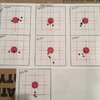tcoz
Member
I shot an OCW test yesterday and would appreciate the opinion of some people more experienced than I am in interpreting them.
Three shot groups at 100 yards fired "round-robin" style with the order of shooting reversed after each string. Barrel was allowed to cool 1-2 minutes between shots. There is a black dot indicating the center of each group. I should have used red dots since it's hard to tell the dot from the shots in some cases unless you look closely.
The second picture is the center of each group plotted on a single target with the charge weights indicated. The one plotted lower left is 41.5gr as part of the charge weight was cut off.
41.8, 42.1 & 42.4 are the three consecutively charged groups closest together which would lead me to choose 42.1 as my OCW. I don't have a range longer than 100 yards to verify results so I'll have to go with what I have here but I'm not very experienced in assessing the results. Any input will be appreciated.


Three shot groups at 100 yards fired "round-robin" style with the order of shooting reversed after each string. Barrel was allowed to cool 1-2 minutes between shots. There is a black dot indicating the center of each group. I should have used red dots since it's hard to tell the dot from the shots in some cases unless you look closely.
The second picture is the center of each group plotted on a single target with the charge weights indicated. The one plotted lower left is 41.5gr as part of the charge weight was cut off.
41.8, 42.1 & 42.4 are the three consecutively charged groups closest together which would lead me to choose 42.1 as my OCW. I don't have a range longer than 100 yards to verify results so I'll have to go with what I have here but I'm not very experienced in assessing the results. Any input will be appreciated.




